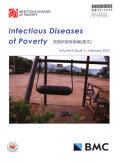- 钛学术文献服务平台 \
- 学术期刊 \
- 医药卫生期刊 \
- 内科学期刊 \
- 贫困所致传染病(英文)期刊 \
null
A neglected risk for sparganosis: eating live tadpoles in central China
基本信息来源于合作网站,原文需代理用户跳转至来源网站获取
摘要:
A 29-year-old farmer from central China was sent into the Emergency Department of the Affiliated Hospital of Zhengzhou University.He had a 15-day history of persistent high fever,abdominal distention and pain.The patient was clinically diagnosed as appendicitis and peritonitis,and treated with antibiotics in a local hospital,did not improve.On exploratory laparotomy,the appendicular perforation and peritonitis were seen;appendicectomy were performed,and antibiotics were given.However,high fever and abdominal pain still persisted;intestinal adhesion and obstruction,ascites appeared.He was given the "critically ill notice".He had eosinophilia (12.95%) and the history of eating live frog tadpoles for treating his cutaneous pruritus 3 days before onset of the disease.Serum anti-sparganum antibodies assayed by ELISA were positive.This patient has hospitalized for one and half months and spend more than USS 12 000.This patient was primarily diagnosed as visceral sparganosis,and cured with praziquantel.Sparganosis is one neglected but important parasitic zoonosis of poverty.Human infections were mainly acquired by eating raw or uncooked meat of frogs and snakes infected with plerocercoids,using frog or snake flesh as poultices,or drinking raw water contaminated with infected copepods.However,sparganosis caused by ingestion of live tadpoles are emerging in central China.Our surveys showed that 1 1.93% of tadpoles in Henan province are infected with plerocercoids.Eating live tadpoles is a high risk for sparganum infection.The comprehensive public health education should be carried out for people in endemic areas and the bad habit of eating live tadpoles must be discouraged.

推荐文章
期刊_丙丁烷TDLAS测量系统的吸收峰自动检测
带间级联激光器
调谐半导体激光吸收光谱
雾剂检漏 中红外吸收峰 洛伦兹光谱线型
不同盐度、温度及光照对漂浮浒苔生理生态的影响
浒苔
盐度
温度
光照
生理生态
期刊_联合空间信息的改进低秩稀疏矩阵分解的高光谱异常目标检测
高光谱图像
异常目标检测 低秩稀疏矩阵分解 稀疏矩阵 残差矩阵
内容分析
关键词云
关键词热度
相关文献总数
(/次)
(/年)
文献信息
| 篇名 | A neglected risk for sparganosis: eating live tadpoles in central China | ||
| 来源期刊 | 贫困所致传染病(英文) | 学科 | |
| 关键词 | |||
| 年,卷(期) | 2017,(3) | 所属期刊栏目 | |
| 研究方向 | 页码范围 | 69-72 | |
| 页数 | 4页 | 分类号 | |
| 字数 | 语种 | 英文 | |
| DOI | 10.1186/s40249-017-0265-7 | ||
五维指标
引文网络
引文网络
二级参考文献 (0)
共引文献 (0)
参考文献 (11)
节点文献
引证文献 (0)
同被引文献 (0)
二级引证文献 (0)
1996(1)
- 参考文献(1)
- 二级参考文献(0)
2009(1)
- 参考文献(1)
- 二级参考文献(0)
2011(2)
- 参考文献(2)
- 二级参考文献(0)
2013(1)
- 参考文献(1)
- 二级参考文献(0)
2014(2)
- 参考文献(2)
- 二级参考文献(0)
2015(3)
- 参考文献(3)
- 二级参考文献(0)
2016(1)
- 参考文献(1)
- 二级参考文献(0)
2017(0)
- 参考文献(0)
- 二级参考文献(0)
- 引证文献(0)
- 二级引证文献(0)
引文网络交叉学科
相关学者/机构
期刊影响力
贫困所致传染病(英文)
主办单位:
中华医学会
出版周期:
双月刊
ISSN:
2095-5162
CN:
10-1399/R
开本:
出版地:
上海市黄浦区瑞金二路207号
邮发代号:
创刊时间:
2016
语种:
eng
出版文献量(篇)
434
总下载数(次)
0
总被引数(次)
45
期刊文献
相关文献
推荐文献

 免费查重
免费查重










